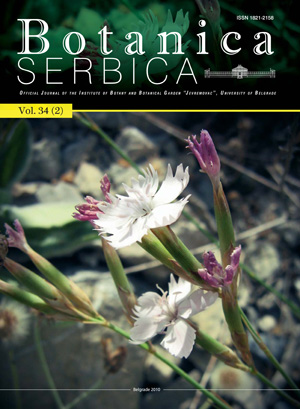
Volume 34 Issue 2 2010 |
Contribution to the knowledge of serpentine fl ora in Kosovo’s part of the Ibar river valley |
KEY WORDS: vascular fl ora, distribution, new chorological data, the Ibar river valley, Kosovo and Metohija, Serbia |
Microscopic algae from karst lakes of Dumre region (Central Albania) |
The diversity of diatoms found in Dumre lakes can be considered high, despite the limited number of samples examined. About 220 taxa of microscopic algae, diatoms (Bacillariophyta), were found in all the collected samples, represented mainly from the genera Navicula (28 species), Nitzschia (23) and Cyclotella (17). More than 170 species were found in the littoral samples of diff erent lakes, where the sample from Cepi, a shallow eutrophic pond was the richest with diatoms, more than 90 species. About 140 species were found in the core sample from Belshi lake, represented mainly from Achnnathes minutissima, Cyclotella ocellata, C. stelligera, Gyrosigma acuminatum, Cymbella affi nis, Gomphonema olivaceum or Hantzschia amphioxys. Centric diatoms Cyclotella ocellata and C. stelligera, and the pennate Achnanthes minutissima were found also relatively abundant in the population community of each sediment layer. The calculated Trophic Index of Diatoms (TIDIA) in each sediment layer oscillated from 1.2 (oligotroph) to 3.4 (polytroph), showing a moderate pollution with nutrients (phosphorous and nitrogen). Saprobic index seems to be more stable, oscillating from 1.5 (oligosaprob) to 2 (beta-mesosaprob), corresponding to scarcely polluted (I-II class) to moderately polluted water quality (II class). From the rare and interesting species of the karst lakes here were mentionioned Caloneis cf. aerophila, Gomphonema augur, Neidium bisulcatum var. subampliatum, Nitzschia geitleri, N. lorenziana, Placoneis elginensis, P. clementioides, Sellaphora levissima, Surirella venusta, Surirella cf. tenera. Caloneis sp. and Surirella sp. represent interesting or new species. The terrigenous hilly relief, the typical Mediterranean climate characteristics combined also with poor land use activities (land denuding), can be the principal causes of the relatively high rate of sedimentation observed in Belshi lake. The decentralized management of wastewater is recommended to prevent the eutrophication processes, and protect the water quality of the lakes. Moreover, forestation activities especially in denuded area would restore the vegetation cover and decrease the erosion. KEY WORDS: Albanian karst lakes; Belshi lake; sediment core sampling; Albanian diatoms |
Costal vegetation of the Lalzi bay (Albania) |
KEY WORDS: sandy dunes, phytosociology, vegetation dynamics |
Contribution to the Bryophyte flora of the Vršacke Planine Mts., Serbia |
KEY WORDS: bryophytes, Vršacke Planine Mts., flora, Serbia |
Typha domingensis (Typhaceae) new to Serbia |
KEY WORDS: Typha domingensis, Typhaceae, new record, flora of Serbia |
Cytogenetic eff ects induced by Manganese and Lead microelements on germination at Allium cepa |
KEY WORDS: cytogenetic eff ects, Allium cepa L., manganese, lead, chromosomal aberrations |
Evaluation of antioxidant activity in some Geraniacean species |
KEY WORDS: antioxidant, DPPH, Geraniaceae |
On the taxonomical identity of Abies alba ssp. borisii-regis (Mattf.)Koz. et Andr.– morphometry, flavonoids and chorology in Bulgaria |
KEY WORDS: cluster analysis, Abies alba ssp. borisii-regis, Abies alba, Abies cephalonica, variation coeffi cient, flavonoids. |
Comparative study of total phenolic content and radical scavenging activity of conventionally and organically grown herbs |
KEY WORDS: organically and conventionally grown herbs; total phenolic content; DPPH radical scavenging activity |
Biology, life-strategy and invasiveness of Amaranthus retrofl exus L. (Amaranthaceae)in central Italy: preliminary remarks |
KEY WORDS: Alien species, Amaranthus, biology, invasiveness, life-strategies |
Pollen Morphology of Iranian Celtis (Celtidaceae -Ulmaceae) |
KEY WORDS: Pollen, Celtis, Iran, Africa. |
In vitro propagation of Dianthus ciliatus ssp. dalmaticus and D. giganteus ssp. croaticus (Caryophyllaceae) from stem segment cultures |
KEY WORDS: Dianthus ciliatus ssp. dalmaticus, Dianthus giganteus ssp. croaticus, adventitious buds, somatic embriogenesis, somatic embryo like structure, micropropagation, organogenesis, stem segment culture |
New records for the Albanian flora |
KEY WORDS: Albania, flora, new records, plant distribution |


